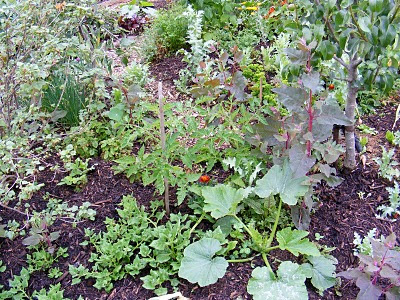Oca has demonstrated to me that it can look after itself without protection, special feeding, or formalised cultural methods. It can blot out competing weeds, and it has its own chemical defences against some pathogens and pest insects, and can possibly (pending trial) chemically inhibit the growth of competing plant neighbours. It can mix it with the big boys, and it's time it left the easy-life behind. No more pampering. No more chitting near the radiator. No more rubbing shoulders with frilly lettuce and F1 hybrids with Italian-sounding names.
It's high time Oca got on its bike and learned to make its own way in the meritocracy of My Other Allotment.
To explain things ... my Other Allotment is the antithesis of my first allotment. It is something like a developing edible forest garden without the canopy layer. Plants are mostly either perennial, self-sown, or plant-replant tubers. Any form of cultivation, watering, or weeding is rare. Call it a sink-or-swim free-range low-input happy-accident ultimate polyculture garden if you like. Some vague order is maintained by mulching, and very occasional strategic guidance and weed removal.
without the canopy layer. Plants are mostly either perennial, self-sown, or plant-replant tubers. Any form of cultivation, watering, or weeding is rare. Call it a sink-or-swim free-range low-input happy-accident ultimate polyculture garden if you like. Some vague order is maintained by mulching, and very occasional strategic guidance and weed removal.
Below: Wormwood, Japanese Wineberry, and Yacon, with volunteer Perpetual Spinach, red-leaved Beetroot, and tomatoes (at rear). Oca could compete here.
Below: Wormwood, Japanese Wineberry, and Yacon, with volunteer Perpetual Spinach, red-leaved Beetroot, and tomatoes (at rear). Oca could compete here.
Below: I count at least 20 edible species in this corner of the plot. But there is still space to spare for Oca.

Below: Mulched soil surface with self-sown red orach, New-Zealand spinach, and red-veined sorrel. Oca could fit in to this niche.
Conventionally, root-crops do not mix well with perennials, because harvesting the root-crop disturbs them. But I am going to release a few Oca in to this wild system, and see where it survives, and where the tubers can be got at without digging deep. Absence of cultivation for several years, coupled with occasional mulching, has produced a high-organic-content layer on the surface, which will be easy to scratch through to collect tubers. Those that are missed will seed the following year's crop. At least that is the plan!
25/4/10 The soil has warmed up nicely, so today is planting day. Basically, I'm just finding gaps between existing plants, scooping out a depression with the spade, dropping in a sprouting tuber, and dumping a shovelful of rough garden compost on top. More mulch will be added during the season, and I'm hoping this will encourage the tubers to develop near the surface, making them easy to harvest. The photo below shows a planting in a bed that has been reworked this Spring. I'll be adding other plants – yacon, and mashua, – for an Andean tuberous hotch-potch, conveniently all harvested at the same time of year.
25/4/10 The soil has warmed up nicely, so today is planting day. Basically, I'm just finding gaps between existing plants, scooping out a depression with the spade, dropping in a sprouting tuber, and dumping a shovelful of rough garden compost on top. More mulch will be added during the season, and I'm hoping this will encourage the tubers to develop near the surface, making them easy to harvest. The photo below shows a planting in a bed that has been reworked this Spring. I'll be adding other plants – yacon, and mashua, – for an Andean tuberous hotch-potch, conveniently all harvested at the same time of year.
This trial will be ongoing. Come back to this post for regular updates.
And I'm keen to hear from anyone with experience of growing Oca in similar circumstances.
Above: 12/7/10 This view shows the same area. The Oca now have yacon, tuberous nasturtiums, broad beans, and yarrow as neighbours. There's been a prolonged dry hot period, and the Oca are showing signs of stress, though have still managed to put on good growth. Others located elsewhere with more shade and moisture look fresher and happier, but are not so large as these.
And I'm keen to hear from anyone with experience of growing Oca in similar circumstances.
Above: 12/7/10 This view shows the same area. The Oca now have yacon, tuberous nasturtiums, broad beans, and yarrow as neighbours. There's been a prolonged dry hot period, and the Oca are showing signs of stress, though have still managed to put on good growth. Others located elsewhere with more shade and moisture look fresher and happier, but are not so large as these.




Nice look set of self reliant edibles you have there. I am intrigued to see how your Oca does solo.
ReplyDeleteThank you Ottawa Gardener. I'm guessing your growing season will be too short to get a worthwhile oca crop. But you could always use a polytunnel!
ReplyDelete